park assist BMW 740LI SEDAN 2012 User Guide
[x] Cancel search | Manufacturer: BMW, Model Year: 2012, Model line: 740LI SEDAN, Model: BMW 740LI SEDAN 2012Pages: 299, PDF Size: 8.49 MB
Page 120 of 299
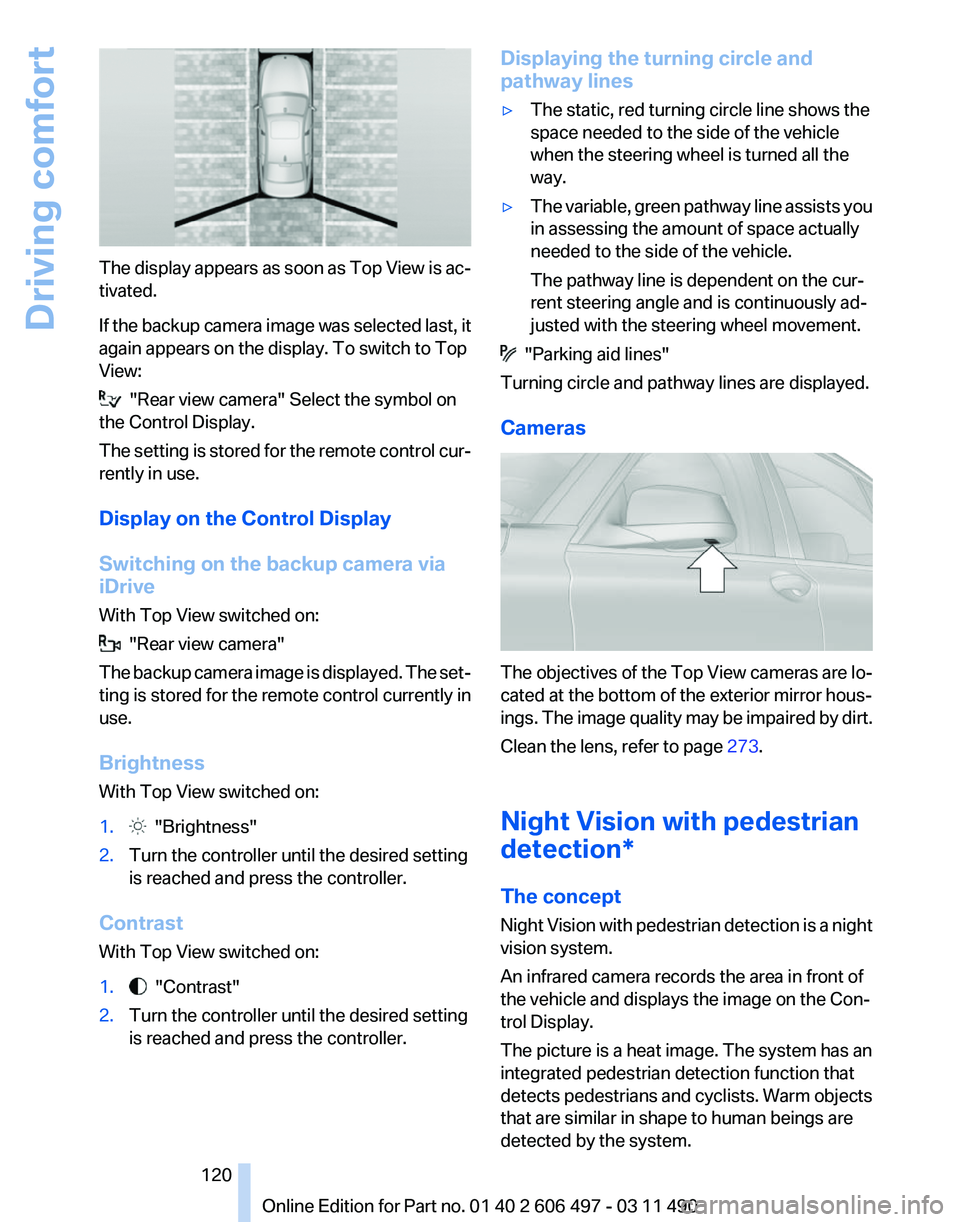
The display appears as soon as Top View is ac‚Äź
tivated.
If
the backup camera image was selected last, it
again appears on the display. To switch to Top
View: "Rear view camera" Select the symbol on
the Control Display.
The
setting is stored for the remote control cur‚Äź
rently in use.
Display on the Control Display
Switching on the backup camera via
iDrive
With Top View switched on: "Rear view camera"
The
backup camera image is displayed. The set‚Äź
ting is stored for the remote control currently in
use.
Brightness
With Top View switched on:
1. "Brightness"
2. Turn the controller until the desired setting
is reached and press the controller.
Contrast
With Top View switched on:
1. "Contrast"
2. Turn the controller until the desired setting
is reached and press the controller. Displaying the turning circle and
pathway lines
‚Ė∑
The static, red turning circle line shows the
space needed to the side of the vehicle
when the steering wheel is turned all the
way.
‚Ė∑ The variable, green pathway line assists you
in assessing the amount of space actually
needed to the side of the vehicle.
The pathway line is dependent on the cur‚Äź
rent steering angle and is continuously ad‚Äź
justed with the steering wheel movement. "Parking aid lines"
Turning circle and pathway lines are displayed.
Cameras The objectives of the Top View cameras are lo‚Äź
cated at the bottom of the exterior mirror hous‚Äź
ings.
The image quality may be impaired by dirt.
Clean the lens, refer to page 273.
Night Vision with pedestrian
detection*
The concept
Night Vision with pedestrian detection is a night
vision system.
An infrared camera records the area in front of
the vehicle and displays the image on the Con‚Äź
trol Display.
The picture is a heat image. The system has an
integrated pedestrian detection function that
detects pedestrians and cyclists. Warm objects
that are similar in shape to human beings are
detected by the system.
Seite 120
120 Online Edition for Part no. 01 40 2 606 497 - 03 11 490
Driving comfort
Page 146 of 299
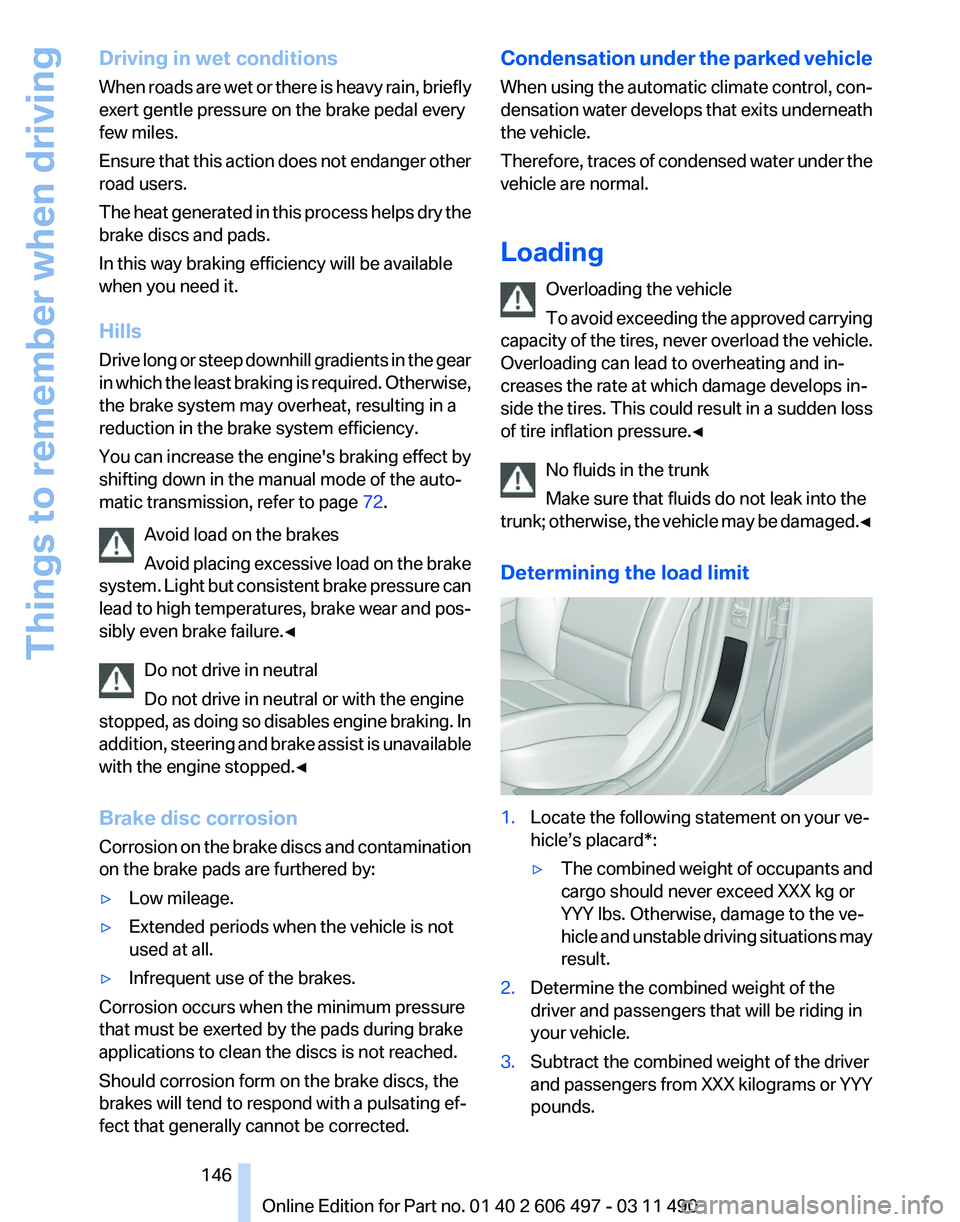
Driving in wet conditions
When
roads are wet or there is heavy rain, briefly
exert gentle pressure on the brake pedal every
few miles.
Ensure that this action does not endanger other
road users.
The heat generated in this process helps dry the
brake discs and pads.
In this way braking efficiency will be available
when you need it.
Hills
Drive long or steep downhill gradients in the gear
in which the least braking is required. Otherwise,
the brake system may overheat, resulting in a
reduction in the brake system efficiency.
You can increase the engine's braking effect by
shifting down in the manual mode of the auto‚Äź
matic transmission, refer to page 72.
Avoid load on the brakes
Avoid placing excessive load on the brake
system. Light but consistent brake pressure can
lead to high temperatures, brake wear and pos‚Äź
sibly even brake failure.‚óÄ
Do not drive in neutral
Do not drive in neutral or with the engine
stopped, as doing so disables engine braking. In
addition, steering and brake assist is unavailable
with the engine stopped.‚óÄ
Brake disc corrosion
Corrosion on the brake discs and contamination
on the brake pads are furthered by:
‚Ė∑ Low mileage.
‚Ė∑ Extended periods when the vehicle is not
used at all.
‚Ė∑ Infrequent use of the brakes.
Corrosion occurs when the minimum pressure
that must be exerted by the pads during brake
applications to clean the discs is not reached.
Should corrosion form on the brake discs, the
brakes will tend to respond with a pulsating ef‚Äź
fect that generally cannot be corrected. Condensation under the parked vehicle
When
using the automatic climate control, con‚Äź
densation water develops that exits underneath
the vehicle.
Therefore, traces of condensed water under the
vehicle are normal.
Loading
Overloading the vehicle
To avoid exceeding the approved carrying
capacity of the tires, never overload the vehicle.
Overloading can lead to overheating and in‚Äź
creases the rate at which damage develops in‚Äź
side the tires. This could result in a sudden loss
of tire inflation pressure.‚óÄ
No fluids in the trunk
Make sure that fluids do not leak into the
trunk; otherwise, the vehicle may be damaged.‚óÄ
Determining the load limit 1.
Locate the following statement on your ve‚Äź
hicle’s placard*:
‚Ė∑The combined weight of occupants and
cargo should never exceed XXX kg or
YYY lbs. Otherwise, damage to the ve‚Äź
hicle
and unstable driving situations may
result.
2. Determine the combined weight of the
driver and passengers that will be riding in
your vehicle.
3. Subtract the combined weight of the driver
and
passengers from XXX kilograms or YYY
pounds. Seite 146
146 Online Edition for Part no. 01 40 2 606 497 - 03 11 490
Things to remember when driving
Page 236 of 299
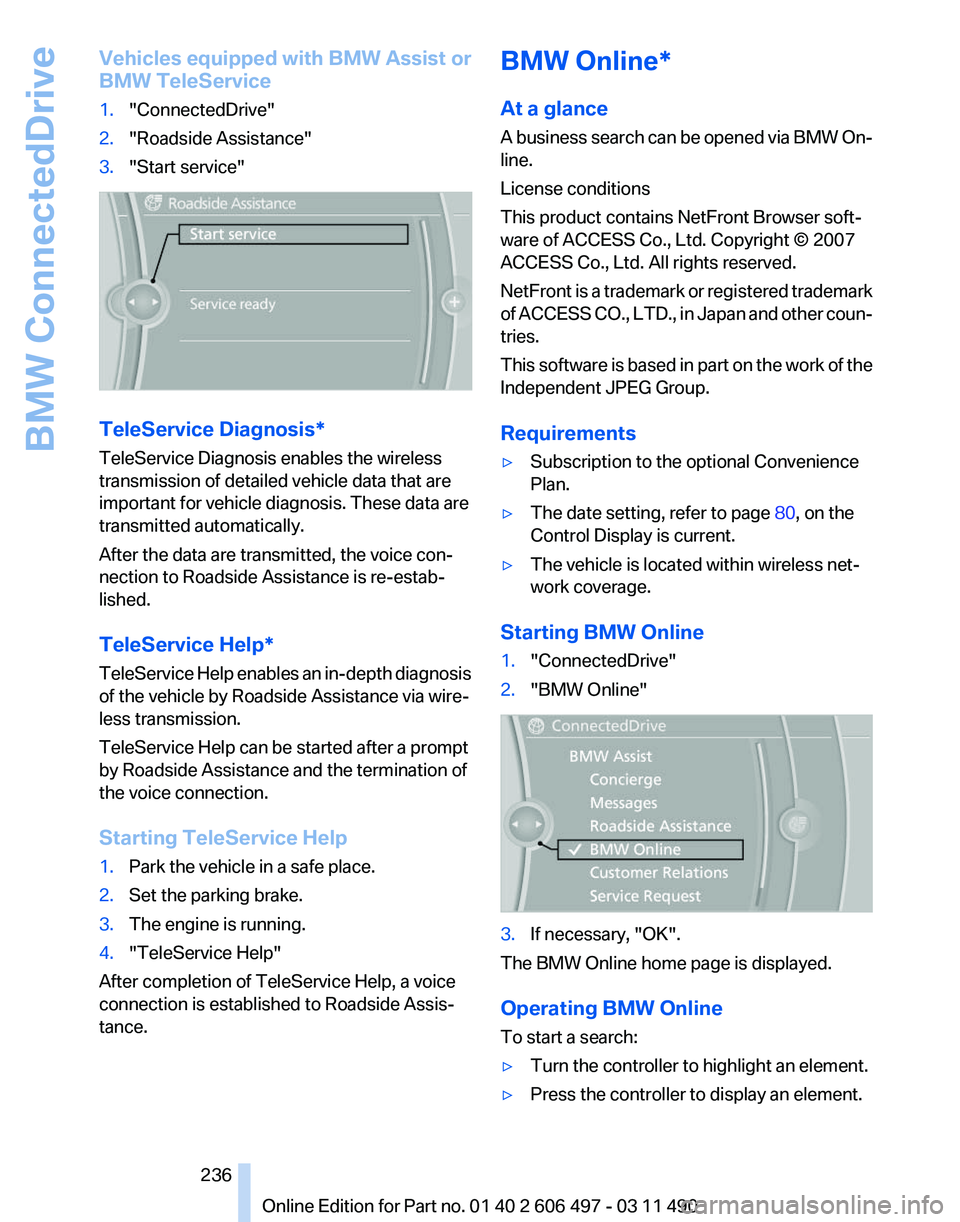
Vehicles equipped with BMW Assist or
BMW TeleService
1.
"ConnectedDrive"
2. "Roadside Assistance"
3. "Start service" TeleService Diagnosis*
TeleService Diagnosis enables the wireless
transmission of detailed vehicle data that are
important for vehicle diagnosis. These data are
transmitted automatically.
After the data are transmitted, the voice con‚Äź
nection to Roadside Assistance is re-estab‚Äź
lished.
TeleService Help
*
TeleService Help enables an in-depth diagnosis
of the vehicle by Roadside Assistance via wire‚Äź
less transmission.
TeleService Help can be started after a prompt
by Roadside Assistance and the termination of
the voice connection.
Starting TeleService Help
1. Park the vehicle in a safe place.
2. Set the parking brake.
3. The engine is running.
4. "TeleService Help"
After completion of TeleService Help, a voice
connection is established to Roadside Assis‚Äź
tance. BMW Online*
At a glance
A
business search can be opened via BMW On‚Äź
line.
License conditions
This product contains NetFront Browser soft‚Äź
ware of ACCESS Co., Ltd. Copyright © 2007
ACCESS Co., Ltd. All rights reserved.
NetFront is a trademark or registered trademark
of ACCESS CO., LTD., in Japan and other coun‚Äź
tries.
This software is based in part on the work of the
Independent JPEG Group.
Requirements
‚Ė∑ Subscription to the optional Convenience
Plan.
‚Ė∑ The date setting, refer to page 80, on the
Control Display is current.
‚Ė∑ The vehicle is located within wireless net‚Äź
work coverage.
Starting BMW Online
1. "ConnectedDrive"
2. "BMW Online" 3.
If necessary, "OK".
The BMW Online home page is displayed.
Operating BMW Online
To start a search:
‚Ė∑ Turn the controller to highlight an element.
‚Ė∑ Press the controller to display an element.
Seite 236
236 Online Edition for Part no. 01 40 2 606 497 - 03 11 490
BMW ConnectedDrive
Page 268 of 299
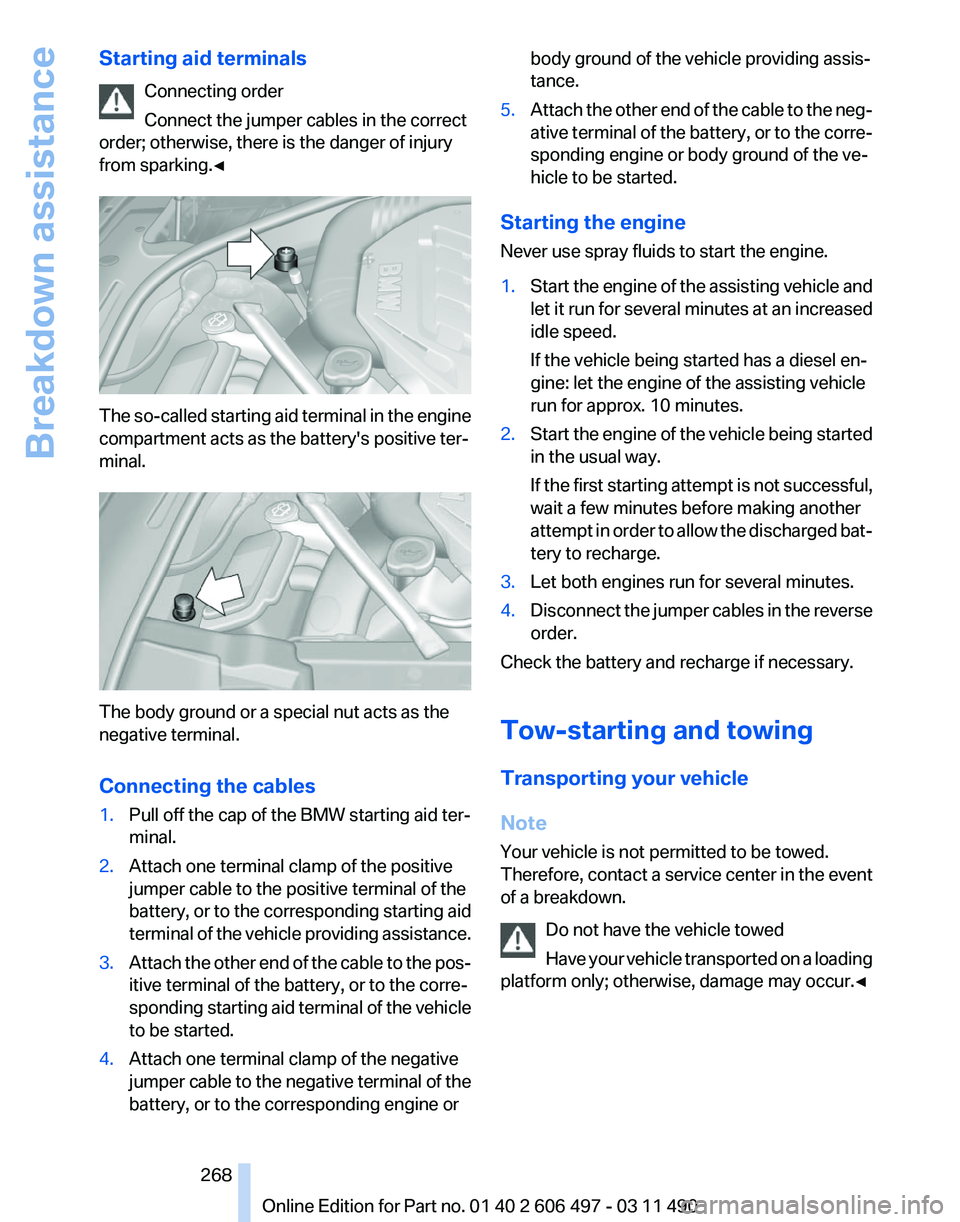
Starting aid terminals
Connecting order
Connect the jumper cables in the correct
order; otherwise, there is the danger of injury
from sparking.‚óÄ The so-called starting aid terminal in the engine
compartment acts as the battery's positive ter‚Äź
minal.
The body ground or a special nut acts as the
negative terminal.
Connecting the cables
1.
Pull off the cap of the BMW starting aid ter‚Äź
minal.
2. Attach one terminal clamp of the positive
jumper cable to the positive terminal of the
battery,
or to the corresponding starting aid
terminal of the vehicle providing assistance.
3. Attach the other end of the cable to the pos‚Äź
itive terminal of the battery, or to the corre‚Äź
sponding
starting aid terminal of the vehicle
to be started.
4. Attach one terminal clamp of the negative
jumper
cable to the negative terminal of the
battery, or to the corresponding engine or body ground of the vehicle providing assis‚Äź
tance.
5. Attach the other end of the cable to the neg‚Äź
ative
terminal of the battery, or to the corre‚Äź
sponding engine or body ground of the ve‚Äź
hicle to be started.
Starting the engine
Never use spray fluids to start the engine.
1. Start the engine of the assisting vehicle and
let
it run for several minutes at an increased
idle speed.
If the vehicle being started has a diesel en‚Äź
gine: let the engine of the assisting vehicle
run for approx. 10 minutes.
2. Start the engine of the vehicle being started
in the usual way.
If
the first starting attempt is not successful,
wait a few minutes before making another
attempt in order to allow the discharged bat‚Äź
tery to recharge.
3. Let both engines run for several minutes.
4. Disconnect the jumper cables in the reverse
order.
Check the battery and recharge if necessary.
Tow-starting and towing
Transporting your vehicle
Note
Your vehicle is not permitted to be towed.
Therefore,
contact a service center in the event
of a breakdown.
Do not have the vehicle towed
Have your vehicle transported on a loading
platform only; otherwise, damage may occur.‚óÄ Seite 268
268 Online Edition for Part no. 01 40 2 606 497 - 03 11 490
Breakdown assistance
Page 290 of 299
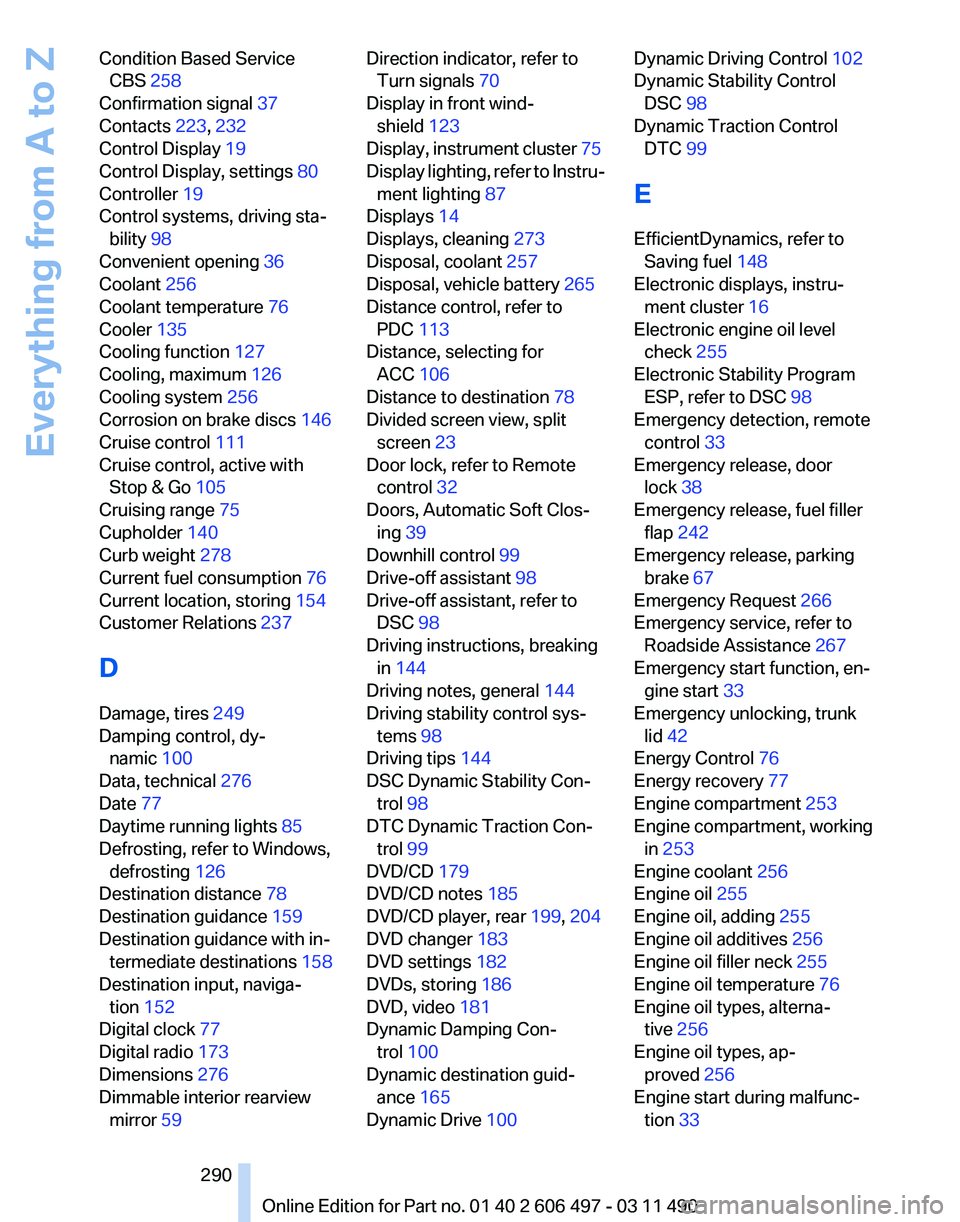
Condition Based Service
CBS 258
Confirmation signal 37
Contacts 223, 232
Control Display 19
Control Display, settings 80
Controller 19
Control systems, driving sta‚Äź bility 98
Convenient opening 36
Coolant 256
Coolant temperature 76
Cooler 135
Cooling function 127
Cooling, maximum 126
Cooling system 256
Corrosion on brake discs 146
Cruise control 111
Cruise control, active with Stop & Go 105
Cruising range 75
Cupholder 140
Curb weight 278
Current fuel consumption 76
Current location, storing 154
Customer Relations 237
D
Damage, tires 249
Damping control, dy‚Äź namic 100
Data, technical 276
Date 77
Daytime running lights 85
Defrosting, refer to Windows, defrosting 126
Destination distance 78
Destination guidance 159
Destination guidance with in‚Äź termediate destinations 158
Destination input, naviga‚Äź tion 152
Digital clock 77
Digital radio 173
Dimensions 276
Dimmable interior rearview mirror 59 Direction indicator, refer to
Turn signals 70
Display in front wind‚Äź shield 123
Display,
instrument cluster 75
Display lighting, refer to Instru‚Äź ment lighting 87
Displays 14
Displays, cleaning 273
Disposal, coolant 257
Disposal, vehicle battery 265
Distance control, refer to PDC 113
Distance, selecting for ACC 106
Distance to destination 78
Divided screen view, split screen 23
Door lock, refer to Remote control 32
Doors, Automatic Soft Clos‚Äź ing 39
Downhill control 99
Drive-off assistant 98
Drive-off assistant, refer to DSC 98
Driving instructions, breaking in 144
Driving notes, general 144
Driving stability control sys‚Äź tems 98
Driving tips 144
DSC Dynamic Stability Con‚Äź trol 98
DTC Dynamic Traction Con‚Äź trol 99
DVD/CD 179
DVD/CD notes 185
DVD/CD player, rear 199, 204
DVD changer 183
DVD settings 182
DVDs, storing 186
DVD, video 181
Dynamic Damping Con‚Äź trol 100
Dynamic destination guid‚Äź ance 165
Dynamic Drive 100 Dynamic Driving Control
102
Dynamic Stability Control DSC 98
Dynamic Traction Control DTC 99
E
EfficientDynamics, refer to Saving fuel 148
Electronic displays, instru‚Äź ment cluster 16
Electronic engine oil level check 255
Electronic Stability Program ESP, refer to DSC 98
Emergency detection, remote control 33
Emergency release, door lock 38
Emergency release, fuel filler flap 242
Emergency release, parking brake 67
Emergency Request 266
Emergency service, refer to Roadside Assistance 267
Emergency start function, en‚Äź gine start 33
Emergency unlocking, trunk lid 42
Energy Control 76
Energy recovery 77
Engine compartment 253
Engine compartment, working in 253
Engine coolant 256
Engine oil 255
Engine oil, adding 255
Engine oil additives 256
Engine oil filler neck 255
Engine oil temperature 76
Engine oil types, alterna‚Äź tive 256
Engine oil types, ap‚Äź proved 256
Engine start during malfunc‚Äź tion 33
Seite 290
290 Online Edition for Part no. 01 40 2 606 497 - 03 11 490
Everything from A to Z
Page 291 of 299
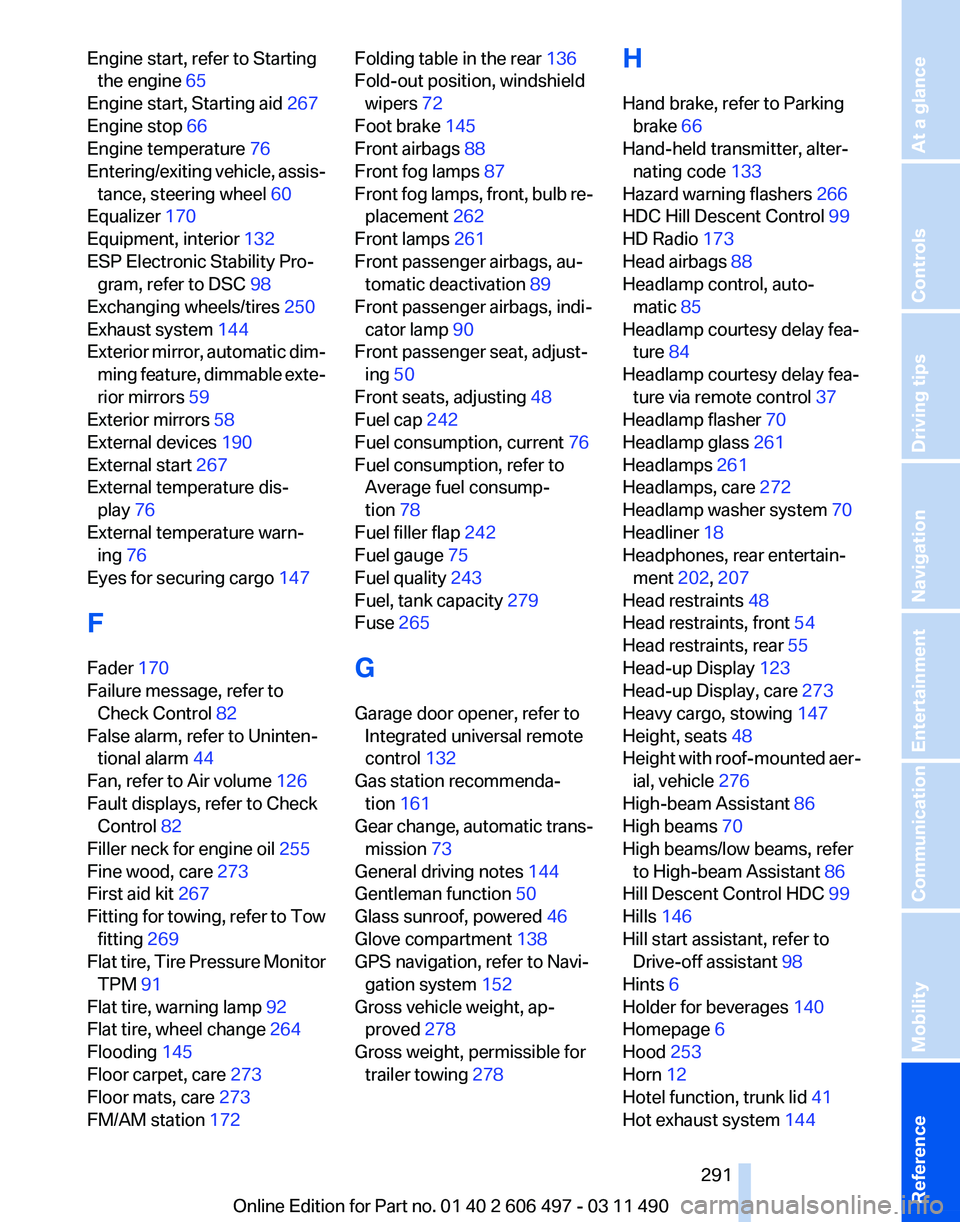
Engine start, refer to Starting
the engine 65
Engine start, Starting aid 267
Engine stop 66
Engine temperature 76
Entering/exiting
vehicle, assis‚Äź
tance, steering wheel 60
Equalizer 170
Equipment, interior 132
ESP Electronic Stability Pro‚Äź gram, refer to DSC 98
Exchanging wheels/tires 250
Exhaust system 144
Exterior mirror, automatic dim‚Äź ming feature, dimmable exte‚Äź
rior mirrors 59
Exterior mirrors 58
External devices 190
External start 267
External temperature dis‚Äź play 76
External temperature warn‚Äź ing 76
Eyes for securing cargo 147
F
Fader 170
Failure message, refer to Check Control 82
False alarm, refer to Uninten‚Äź tional alarm 44
Fan, refer to Air volume 126
Fault displays, refer to Check Control 82
Filler neck for engine oil 255
Fine wood, care 273
First aid kit 267
Fitting for towing, refer to Tow fitting 269
Flat tire, Tire Pressure Monitor TPM 91
Flat tire, warning lamp 92
Flat tire, wheel change 264
Flooding 145
Floor carpet, care 273
Floor mats, care 273
FM/AM station 172 Folding table in the rear
136
Fold-out position, windshield wipers 72
Foot brake 145
Front airbags 88
Front fog lamps 87
Front
fog lamps, front, bulb re‚Äź
placement 262
Front lamps 261
Front passenger airbags, au‚Äź tomatic deactivation 89
Front passenger airbags, indi‚Äź cator lamp 90
Front passenger seat, adjust‚Äź ing 50
Front seats, adjusting 48
Fuel cap 242
Fuel consumption, current 76
Fuel consumption, refer to Average fuel consump‚Äź
tion 78
Fuel filler flap 242
Fuel gauge 75
Fuel quality 243
Fuel, tank capacity 279
Fuse 265
G
Garage door opener, refer to Integrated universal remote
control 132
Gas station recommenda‚Äź tion 161
Gear change, automatic trans‚Äź mission 73
General driving notes 144
Gentleman function 50
Glass sunroof, powered 46
Glove compartment 138
GPS navigation, refer to Navi‚Äź gation system 152
Gross vehicle weight, ap‚Äź proved 278
Gross weight, permissible for trailer towing 278 H
Hand brake, refer to Parking
brake 66
Hand-held transmitter, alter‚Äź nating code 133
Hazard warning flashers 266
HDC Hill Descent Control 99
HD Radio 173
Head airbags 88
Headlamp control, auto‚Äź matic 85
Headlamp courtesy delay fea‚Äź ture 84
Headlamp courtesy delay fea‚Äź ture via remote control 37
Headlamp flasher 70
Headlamp glass 261
Headlamps 261
Headlamps, care 272
Headlamp washer system 70
Headliner 18
Headphones, rear entertain‚Äź ment 202, 207
Head restraints 48
Head restraints, front 54
Head restraints, rear 55
Head-up Display 123
Head-up Display, care 273
Heavy cargo, stowing 147
Height, seats 48
Height
with roof-mounted aer‚Äź
ial, vehicle 276
High-beam Assistant 86
High beams 70
High beams/low beams, refer to High-beam Assistant 86
Hill Descent Control HDC 99
Hills 146
Hill start assistant, refer to Drive-off assistant 98
Hints 6
Holder for beverages 140
Homepage 6
Hood 253
Horn 12
Hotel function, trunk lid 41
Hot exhaust system 144
Seite 291
291Online Edition for Part no. 01 40 2 606 497 - 03 11 490
Reference Mobility Communication Entertainment Navigation Driving tips Controls At a glance
Page 294 of 299
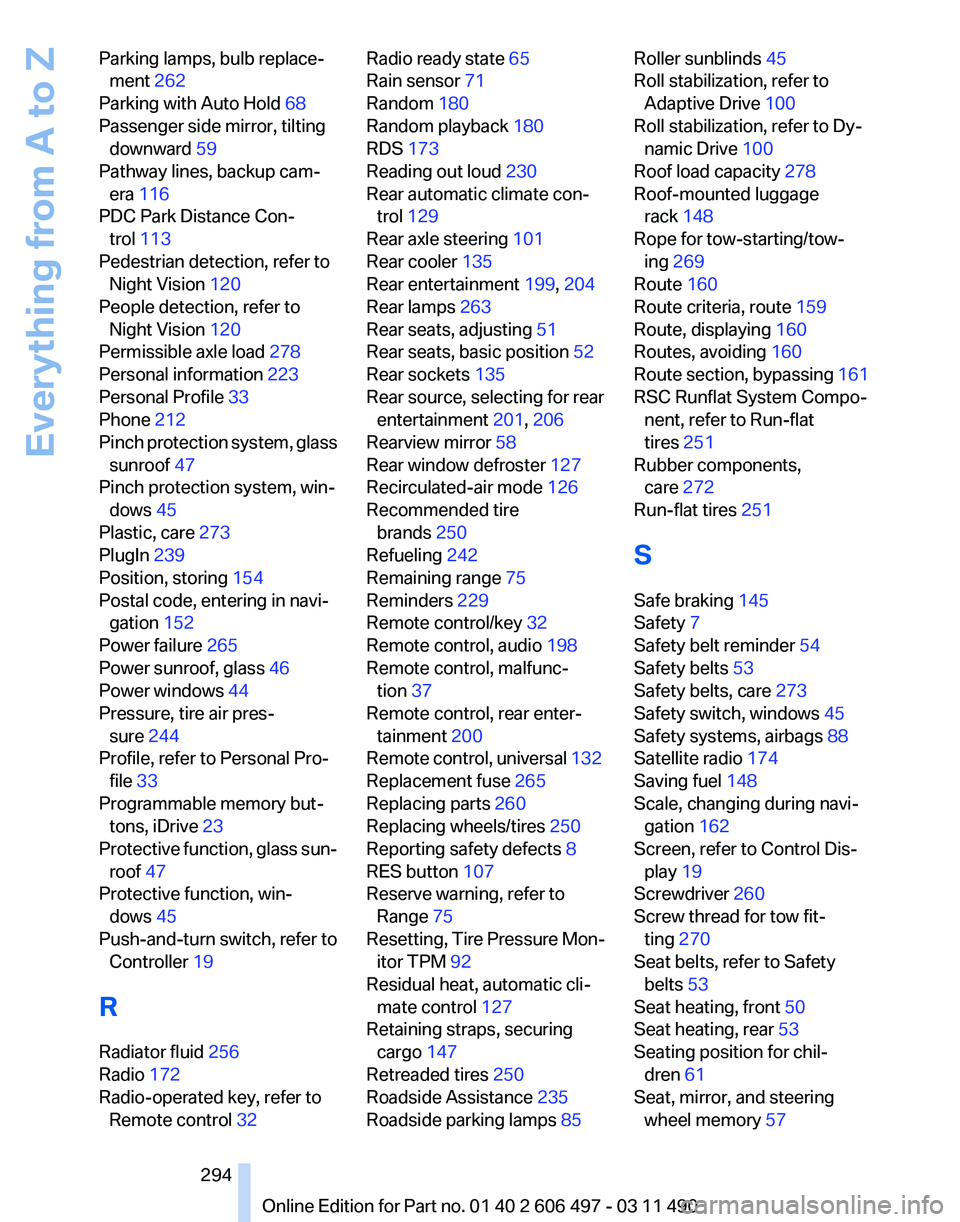
Parking lamps, bulb replace‚Äź
ment 262
Parking with Auto Hold 68
Passenger side mirror, tilting downward 59
Pathway lines, backup cam‚Äź era 116
PDC Park Distance Con‚Äź trol 113
Pedestrian detection, refer to Night Vision 120
People detection, refer to Night Vision 120
Permissible axle load 278
Personal information 223
Personal Profile 33
Phone 212
Pinch
protection system, glass
sunroof 47
Pinch protection system, win‚Äź dows 45
Plastic, care 273
PlugIn 239
Position, storing 154
Postal code, entering in navi‚Äź gation 152
Power failure 265
Power sunroof, glass 46
Power windows 44
Pressure, tire air pres‚Äź sure 244
Profile, refer to Personal Pro‚Äź file 33
Programmable memory but‚Äź tons, iDrive 23
Protective function, glass sun‚Äź roof 47
Protective function, win‚Äź dows 45
Push-and-turn switch, refer to Controller 19
R
Radiator fluid 256
Radio 172
Radio-operated key, refer to Remote control 32 Radio ready state
65
Rain sensor 71
Random 180
Random playback 180
RDS 173
Reading out loud 230
Rear automatic climate con‚Äź trol 129
Rear axle steering 101
Rear cooler 135
Rear entertainment 199, 204
Rear lamps 263
Rear seats, adjusting 51
Rear seats, basic position 52
Rear sockets 135
Rear source, selecting for rear entertainment 201, 206
Rearview mirror 58
Rear window defroster 127
Recirculated-air mode 126
Recommended tire brands 250
Refueling 242
Remaining range 75
Reminders 229
Remote control/key 32
Remote control, audio 198
Remote control, malfunc‚Äź tion 37
Remote control, rear enter‚Äź tainment 200
Remote
control, universal 132
Replacement fuse 265
Replacing parts 260
Replacing wheels/tires 250
Reporting safety defects 8
RES button 107
Reserve warning, refer to Range 75
Resetting, Tire Pressure Mon‚Äź itor TPM 92
Residual heat, automatic cli‚Äź mate control 127
Retaining straps, securing cargo 147
Retreaded tires 250
Roadside Assistance 235
Roadside parking lamps 85 Roller sunblinds 45
Roll stabilization, refer to
Adaptive Drive 100
Roll stabilization, refer to Dy‚Äź namic Drive 100
Roof load capacity 278
Roof-mounted luggage rack 148
Rope for tow-starting/tow‚Äź ing 269
Route 160
Route criteria, route 159
Route, displaying 160
Routes, avoiding 160
Route
section, bypassing 161
RSC Runflat System Compo‚Äź nent, refer to Run-flat
tires 251
Rubber components, care 272
Run-flat tires 251
S
Safe braking 145
Safety 7
Safety belt reminder 54
Safety belts 53
Safety belts, care 273
Safety switch, windows 45
Safety systems, airbags 88
Satellite radio 174
Saving fuel 148
Scale, changing during navi‚Äź gation 162
Screen, refer to Control Dis‚Äź play 19
Screwdriver 260
Screw thread for tow fit‚Äź ting 270
Seat belts, refer to Safety belts 53
Seat heating, front 50
Seat heating, rear 53
Seating position for chil‚Äź dren 61
Seat, mirror, and steering wheel memory 57
Seite 294
294 Online Edition for Part no. 01 40 2 606 497 - 03 11 490
Everything from A to Z